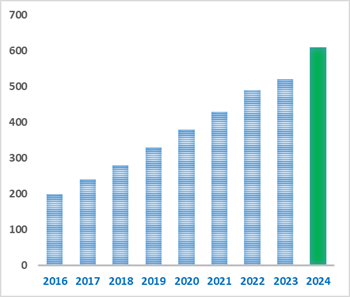MetoclopramideDopamine receptor antagonist CAS# 364-62-5 |

- Dexpramipexole dihydrochloride
Catalog No.:BCC1528
CAS No.:104632-27-1
- Dexpramipexole
Catalog No.:BCC1527
CAS No.:104632-28-2
- Cariprazine hydrochloride
Catalog No.:BCC1454
CAS No.:1083076-69-0
- Cariprazine
Catalog No.:BCC1453
CAS No.:839712-12-8
Quality Control & MSDS
3D structure
Package In Stock
Number of papers citing our products

| Cas No. | 364-62-5 | SDF | Download SDF |
| PubChem ID | 4168 | Appearance | Powder |
| Formula | C14H22ClN3O2 | M.Wt | 299.8 |
| Type of Compound | N/A | Storage | Desiccate at -20°C |
| Solubility | DMSO : ≥ 41 mg/mL (136.76 mM) *"≥" means soluble, but saturation unknown. | ||
| Chemical Name | 4-amino-5-chloro-N-[2-(diethylamino)ethyl]-2-methoxybenzamide | ||
| SMILES | CCN(CC)CCNC(=O)C1=CC(=C(C=C1OC)N)Cl | ||
| Standard InChIKey | TTWJBBZEZQICBI-UHFFFAOYSA-N | ||
| Standard InChI | InChI=1S/C14H22ClN3O2/c1-4-18(5-2)7-6-17-14(19)10-8-11(15)12(16)9-13(10)20-3/h8-9H,4-7,16H2,1-3H3,(H,17,19) | ||
| General tips | For obtaining a higher solubility , please warm the tube at 37 ℃ and shake it in the ultrasonic bath for a while.Stock solution can be stored below -20℃ for several months. We recommend that you prepare and use the solution on the same day. However, if the test schedule requires, the stock solutions can be prepared in advance, and the stock solution must be sealed and stored below -20℃. In general, the stock solution can be kept for several months. Before use, we recommend that you leave the vial at room temperature for at least an hour before opening it. |
||
| About Packaging | 1. The packaging of the product may be reversed during transportation, cause the high purity compounds to adhere to the neck or cap of the vial.Take the vail out of its packaging and shake gently until the compounds fall to the bottom of the vial. 2. For liquid products, please centrifuge at 500xg to gather the liquid to the bottom of the vial. 3. Try to avoid loss or contamination during the experiment. |
||
| Shipping Condition | Packaging according to customer requirements(5mg, 10mg, 20mg and more). Ship via FedEx, DHL, UPS, EMS or other couriers with RT, or blue ice upon request. | ||

Metoclopramide Dilution Calculator

Metoclopramide Molarity Calculator
| 1 mg | 5 mg | 10 mg | 20 mg | 25 mg | |
| 1 mM | 3.3356 mL | 16.6778 mL | 33.3556 mL | 66.7111 mL | 83.3889 mL |
| 5 mM | 0.6671 mL | 3.3356 mL | 6.6711 mL | 13.3422 mL | 16.6778 mL |
| 10 mM | 0.3336 mL | 1.6678 mL | 3.3356 mL | 6.6711 mL | 8.3389 mL |
| 50 mM | 0.0667 mL | 0.3336 mL | 0.6671 mL | 1.3342 mL | 1.6678 mL |
| 100 mM | 0.0334 mL | 0.1668 mL | 0.3336 mL | 0.6671 mL | 0.8339 mL |
| * Note: If you are in the process of experiment, it's necessary to make the dilution ratios of the samples. The dilution data above is only for reference. Normally, it's can get a better solubility within lower of Concentrations. | |||||

Calcutta University

University of Minnesota

University of Maryland School of Medicine

University of Illinois at Chicago

The Ohio State University

University of Zurich

Harvard University

Colorado State University

Auburn University

Yale University

Worcester Polytechnic Institute

Washington State University

Stanford University

University of Leipzig

Universidade da Beira Interior

The Institute of Cancer Research

Heidelberg University

University of Amsterdam

University of Auckland

TsingHua University

The University of Michigan

Miami University

DRURY University

Jilin University

Fudan University

Wuhan University

Sun Yat-sen University

Universite de Paris

Deemed University

Auckland University

The University of Tokyo

Korea University
Metoclopramide is a dopamine receptor antagonist which has been used for treatment of a variety of gastrointestinal symptoms over the last thirty years. In various countries, metoclopramide is the antiemetic drug of choice in pregnant women. Findings provide reassurance regarding the safety of metoclopramide for the fetus when the drug is given to women to relieve nausea and vomiting during pregnancy. Evidence also supports its use for gastroparesis (poor stomach emptying) and gastroesophageal reflux disease. It appears to bind to dopamine D2 receptors where it is a receptor antagonist, and is also a mixed 5-HT3 receptor antagonist/ 5-HT4 receptor agonist.
- α,α'-Bis(4-hydroxy-3,5-dimethylphenyl)-1,4-diisopropylbenzene
Catalog No.:BCC9196
CAS No.:36395-57-0
- 4-Methylhistamine dihydrochloride
Catalog No.:BCC7337
CAS No.:36376-47-3
- Oxyphyllenone A
Catalog No.:BCN7103
CAS No.:363610-34-8
- Cyclo(L-Ala-L-Pro)
Catalog No.:BCN4012
CAS No.:36357-32-1
- YL-109
Catalog No.:BCC5543
CAS No.:36341-25-0
- Piroxicam
Catalog No.:BCC3841
CAS No.:36322-90-4
- Broussonol E
Catalog No.:BCN7996
CAS No.:363134-28-5
- Prostaglandin E2
Catalog No.:BCC7316
CAS No.:363-24-6
- Hederasaponin B
Catalog No.:BCN1085
CAS No.:36284-77-2
- Pitolisant oxalate
Catalog No.:BCC1864
CAS No.:362665-57-4
- Pitolisant
Catalog No.:BCC1862
CAS No.:362665-56-3
- Clemaphenol A
Catalog No.:BCN7834
CAS No.:362606-60-8
- Diazoxide
Catalog No.:BCC6868
CAS No.:364-98-7
- A 419259
Catalog No.:BCC4307
CAS No.:364042-47-7
- N-p-trans-Coumaroyltyramine
Catalog No.:BCN5320
CAS No.:36417-86-4
- Tolperisone HCl
Catalog No.:BCC4740
CAS No.:3644-61-9
- 6-Hydroxystigmasta-4,22-dien-3-one
Catalog No.:BCN5321
CAS No.:36450-01-8
- 6beta-Hydroxystigmast-4-en-3-one
Catalog No.:BCN5322
CAS No.:36450-02-9
- Lucidenic acid SP1
Catalog No.:BCN7969
CAS No.:364622-33-3
- Doripenem Hydrate
Catalog No.:BCC1160
CAS No.:364622-82-2
- Ginsenoside Rk2
Catalog No.:BCN3721
CAS No.:364779-14-6
- Ginsenoside Rk3
Catalog No.:BCN3502
CAS No.:364779-15-7
- Cinacalcet HCl
Catalog No.:BCC4408
CAS No.:364782-34-3
- Methylsynephrine Hydrochloride
Catalog No.:BCN3407
CAS No.:365-26-4
Neuroleptic Malignant Syndrome Secondary to Metoclopramide Use in an Elderly Gastroenterologic Surgery Patient.[Pubmed:28362659]
Gastroenterol Nurs. 2017 Mar/Apr;40(2):93-100.
An 84-year-old African American woman was admitted to the hospital secondary to severe abdominal pain accompanied by septic shock. She underwent exploratory laparotomy, which revealed extensive small bowel necrosis likely due to small bowel torsion. A small bowel resection was performed with primary anastomoses and the patient was subsequently transferred to the intensive care unit (ICU). She recovered from shock but had a persistent gastroparesis interfering with enteral feeding, for which Metoclopramide was prescribed. She was then transferred to a general medical-surgical unit in a stable condition where she received a total of four 10-mg oral doses of Metoclopramide administered every 8 hours. Approximately 32 hours after receiving the first dose of Metoclopramide, the patient was subsequently transferred back to the ICU because of fever and inability to maintain respirations. Neuroleptic malignant syndrome was suspected, and the patient was intubated and received supportive care. After a week in the ICU, she was discharged back to the medical-surgical unit in a stable condition and recovered completely. The patient was later discharged home.
Comparative efficacy of metoclopramide, ondansetron and maropitant in preventing parvoviral enteritis-induced emesis in dogs.[Pubmed:28198032]
J Vet Pharmacol Ther. 2017 Dec;40(6):599-603.
The aim of the study was to evaluate the efficiencies of selected anti-emetic drugs (Metoclopramide, ondansetron and maropitant) in preventing vomiting in the treatment of canine parvoviral enteritis. We designed a randomized, prospective clinical study. PVE quick ELISA test-positive dogs between 4 and 12 months of age were included in the study. Each of Metoclopramide, ondansetron, maropitant and control group had 8 dogs. Metoclopramide and ondansetron were administered as 0.5 mg/kg doses three times a day via intravenous route, and maropitant was administered as 1 mg/kg doses once a day subcutaneously. The number and severity of daily vomitings were recorded. All dogs were treated and monitored for five days; treatments were continued until all animals healed. Metoclopramide, ondansetron and maropitant decreased the severity of vomiting from the first day and the vomiting numbers from the third day in PVE treatment. Obtained results showed that maropitant can be used successfully such as Metoclopramide and ondansetron, which are frequently used for PVE treatment. At the same time, it was discovered that Metoclopramide, ondansetron and maropitant were equally effective in reducing the frequency and severity of vomiting.
Metoclopramide inhibits trigeminovascular activation:evidence for effective acute attack treatment in migraine.[Pubmed:28263512]
Turk J Med Sci. 2017 Feb 27;47(1):343-347.
BACKGROUND/AIM: Metoclopramide is an effective and commonly used medication in acute migraine treatment but an experimental evidence base is lacking. We aimed to investigate the antimigraine effect of Metoclopramide in a migraine model and whether the analgesic effect of Metoclopramide was likely to be D2 receptor-mediated. MATERIALS AND METHODS: Cortical spreading depression (CSD) was used to model migraine in adult male Wistar rats. Five CSDs were induced by pinprick. Metoclopramide (two different doses), raclopride, or 0.9% saline were administered 30 min before CSD induction. Two hours after the experiments, brain tissues were examined for c-fos activation. RESULTS: In Metoclopramide groups brain stem c-fos expression was significantly lower than in the CSD side of the saline group (P = 0.002). In the raclopride group, ipsilateral brain stem c-fos expression was also lower than in the saline group (P = 0.002). No difference in c-fos expression in the ipsilateral trigeminal nucleus caudalis between the raclopride and Metoclopramide groups was observed (P > 0.05). CONCLUSION: Metoclopramide is shown to suppress trigeminovascular activation for the first time, providing an experimental basis for its role in migraine. The analgesic effect of Metoclopramide is likely to be mediated by D2 receptors since raclopride, a selective D2 receptor antagonist, suppresses trigeminovascular activation similarly.
Metoclopramide-induced Serotonin Syndrome.[Pubmed:28321081]
Intern Med. 2017;56(6):737-739.
A 40-year-old woman with bipolar disorder who was taking mirtazapine presented with mydriasis, abnormal diaphoresis, myoclonus and muscle rigidity after taking metocloplamide. Her medical history, which included the use of serotonergic agents, and the presence of symptoms including myoclonus and muscle rigidity were consistent with a diagnosis of serotonin syndrome (SS) according to the Hunter criteria. The symptoms diminished following three days of treatment with oral lorazepam and cyproheptadine and a reduced dose of mirtazapine. Metoclopramide is frequently used to various gastric symptom. Metoclopramide is not widely known to induce SS. This potentially fatal condition should be avoided by exercising care in the use of drugs that have the potential to cause drug-drug interactions.


